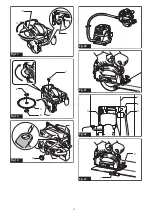
13 ENGLISH
►
Fig.21
Hold the tool firmly. The tool is provided with both a front
grip and rear handle. Use both to best grasp the tool. If
both hands are holding the tool, they cannot be cut by
the circular saw blade. Set the base on the workpiece
to be cut without the circular saw blade making any
contact. Then turn the tool on and wait until the circular
saw blade attains full speed. Now simply move the tool
forward over the workpiece surface, keeping it flat and
advancing smoothly until the cutting is completed.
To get clean cuts, keep your cutting line straight and
your speed of advance uniform. If the cut fails to
properly follow your intended cut line, do not attempt
to turn or force the tool back to the cut line. Doing so
may bind the circular saw blade and lead to dangerous
kickback and possible serious injury. Release switch,
wait for the circular saw blade to stop and then withdraw
tool. Realign tool on new cut line, and start cut again.
Attempt to avoid positioning which exposes operator to
chips and particles being ejected from the tool. Use eye
protection to help avoid injury.
The sight grooves in the base makes it easy to check
the distance between the front edge of the circular saw
blade and the workpiece whenever the circular saw
blade is set to the maximum depth of cut.
►
Fig.22:
1.
Cutting line
2.
Base
3.
Sight grooves
CAUTION:
Do not stack materials when cut-
ting them.
CAUTION:
Do not cut hardened steel, wood,
plastics, concrete, tile, etc. Cut only mild steel,
aluminum and stainless steel with a suitable
circular saw blade.
CAUTION:
Do not touch the circular saw
blade, workpiece or cutting chips with bare hands
immediately after cutting.
They may be extremely
hot and could burn your skin.
CAUTION:
If the tool is operated continuously
until the battery cartridge has discharged, allow
the tool to rest for 15 minutes before proceeding
with a fresh battery.
Rip fence (Guide rule)
Optional accessory
CAUTION:
Make sure that the rip fence is
securely installed in the correct position before
use.
Improper attachment may cause dangerous
kickback.
►
Fig.23:
1.
Rip fence (Guide rule)
2.
Clamping screw
The handy rip fence allows you to do extra-accurate
straight cuts. Simply slide the rip fence up snugly
against the side of the workpiece and secure it in posi-
tion with the clamping screw on the front of the base. It
also makes repeated cuts of uniform width possible.
Lanyard (tether strap) connection
Safety warnings specific for use at height
Read all safety warnings and instructions.
Failure
to follow the warnings and instructions may result in
serious injury.
1.
Always keep the tool tethered when working
"at height". Maximum lanyard length is 2 m
(6.5 ft).
2.
Use only with lanyards appropriate for this tool
type and rated for at least 4.0 kg (8.8 lbs).
3.
Do not anchor the tool lanyard to anything on
your body or on movable components. Anchor
the tool lanyard to a rigid structure that can
withstand the forces of a dropped tool.
4.
Make sure the lanyard is properly secured at
each end prior to use.
5.
Inspect the tool and lanyard before each use
for damage and proper function (including
fabric and stitching). Do not use if damaged or
not functioning properly.
6.
Do not wrap lanyards around or allow them to
come in contact with sharp or rough edges.
7.
Fasten the other end of the lanyard outside
the working area so that a falling tool is held
securely.
8.
Attach the lanyard so that the tool will move
away from the operator if it falls.
Dropped tools
will swing on the lanyard, which could cause injury
or loss of balance.
9.
Do not use near moving parts or running
machinery.
Failure to do so may result in a crush
or entanglement hazard.
10.
Do not carry the tool by the attachment device
or the lanyard.
11.
Only transfer the tool between your hands
while you are properly balanced.
12.
Do not attach lanyards to the tool in a way that
keeps guards, switches or lock-offs from oper-
ating properly.
13.
Avoid getting tangled in the lanyard.
14.
Keep lanyard away from the cutting area of the
tool.
15.
Use multi-action and screw gate type cara-
bineers. Do not use single action spring clip
carabineers.
16.
In the event the tool is dropped, it must be
tagged and removed from service, and should
be inspected by a Makita Factory or Authorized
Service Center.
►
Fig.24:
1.
Hole for lanyard (tether strap)
Содержание DCS553RTJ
Страница 2: ...1 2 3 Fig 1 1 Fig 2 1 2 Fig 3 1 2 Fig 4 1 Fig 5 1 3 2 Fig 6 1 2 3 Fig 7 1 Fig 8 2 ...
Страница 3: ...1 2 Fig 9 Fig 10 2 1 3 Fig 11 2 1 Fig 12 Fig 13 1 2 Fig 14 1 2 Fig 15 1 Fig 16 3 ...
Страница 4: ...1 2 3 4 Fig 17 1 2 3 4 5 Fig 18 1 2 3 Fig 19 Fig 20 Fig 21 1 2 3 3 Fig 22 1 2 Fig 23 4 ...
Страница 5: ...1 Fig 24 5 ...
Страница 83: ...83 ...














































